+Search query
-Structure paper
| Title | GPCRs steer G and G selectivity via TM5-TM6 switches as revealed by structures of serotonin receptors. |
|---|---|
| Journal, issue, pages | Mol Cell, Vol. 82, Issue 14, Page 2681-22695.e6, Year 2022 |
| Publish date | Jul 21, 2022 |
 Authors Authors | Sijie Huang / Peiyu Xu / Dan-Dan Shen / Icaro A Simon / Chunyou Mao / Yangxia Tan / Huibing Zhang / Kasper Harpsøe / Huadong Li / Yumu Zhang / Chongzhao You / Xuekui Yu / Yi Jiang / Yan Zhang / David E Gloriam / H Eric Xu /    |
| PubMed Abstract | Serotonin (or 5-hydroxytryptamine, 5-HT) is an important neurotransmitter that activates 12 different G protein-coupled receptors (GPCRs) through selective coupling of G, G or G proteins. The ...Serotonin (or 5-hydroxytryptamine, 5-HT) is an important neurotransmitter that activates 12 different G protein-coupled receptors (GPCRs) through selective coupling of G, G or G proteins. The structural basis for G protein subtype selectivity by these GPCRs remains elusive. Here, we report the structures of the serotonin receptors 5-HT, 5-HT, and 5-HT with G, and 5-HT with G. The structures reveal that transmembrane helices TM5 and TM6 alternate lengths as a macro-switch to determine receptor's selectivity for G and G, respectively. We find that the macro-switch by the TM5-TM6 length is shared by class A GPCR-G protein structures. Furthermore, we discover specific residues within TM5 and TM6 that function as micro-switches to form specific interactions with G or G. Together, these results present a common mechanism of G versus G protein coupling selectivity or promiscuity by class A GPCRs and extend the basis of ligand recognition at serotonin receptors. |
 External links External links |  Mol Cell / Mol Cell /  PubMed:35714614 PubMed:35714614 |
| Methods | EM (single particle) |
| Resolution | 3.1 - 3.3 Å |
| Structure data | EMDB-33442, PDB-7xt8: EMDB-33443, PDB-7xt9: EMDB-33444, PDB-7xta: EMDB-33445, PDB-7xtb: EMDB-33446, PDB-7xtc: |
| Chemicals |  ChemComp-CLR:  ChemComp-PLM: 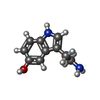 ChemComp-SRO:  ChemComp-8K3: |
| Source |
|
 Keywords Keywords | MEMBRANE PROTEIN / GPCR / serotonin receptor / 5-HT / 5-HT4 receptor / signaling complex / cryo-EM structure / ligand selectivity / G protein selectivity / structure-function relationships / 5-HT6 receptor / 5-HT7 receptor |
 Movie
Movie Controller
Controller Structure viewers
Structure viewers About Yorodumi Papers
About Yorodumi Papers




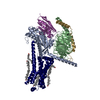

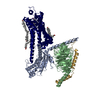

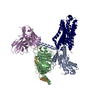

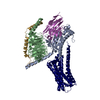


 homo sapiens (human)
homo sapiens (human)
